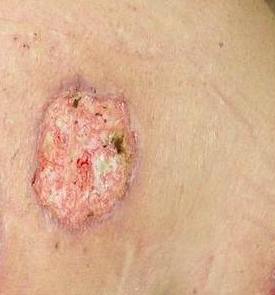 Pyoderma gangrenosum is a non-contagious inflammatory skin disease that can cause large, painful ulcers if not treated. “The first sign of pyoderma gangrenosum is normally a small, red bump similar to a spider bite,” says Dr. Kellie Reed, a board certified Dermatologist at Sanova Dermatology. The bump can break down and develop into an open lesion within a few days. The lesions are most likely to occur on the legs, but really can develop anywhere on the body. Individuals with the condition can experience a number of complications, including infection, uncontrolled pain, scars, and loss of mobility.
Pyoderma gangrenosum is a non-contagious inflammatory skin disease that can cause large, painful ulcers if not treated. “The first sign of pyoderma gangrenosum is normally a small, red bump similar to a spider bite,” says Dr. Kellie Reed, a board certified Dermatologist at Sanova Dermatology. The bump can break down and develop into an open lesion within a few days. The lesions are most likely to occur on the legs, but really can develop anywhere on the body. Individuals with the condition can experience a number of complications, including infection, uncontrolled pain, scars, and loss of mobility.
Causes and Risk Factors for Pyoderma Gangrenosum
Pyoderma gangrenosum is believed to affect about 1 in 100,000 people in the United States each year. “The exact cause of the condition is not known; however, it is often associated with autoimmune diseases such as rheumatoid arthritis, Crohn’s disease, and ulcerative colitis,” says Dr. Reed. Leukemia and other blood cancers can also increase the risk of developing pyoderma gangrenosum. The condition has also been known to occur after a traumatic injury to the skin and in patients without an underlying condition. Although pyoderma gangrenosum can occur at any age, it is most common in adults between the ages of 40 and 50. Women have a slightly higher incidence of the condition than men.
How Is Pyoderma Gangrenosum Treated?
Treatments for pyoderma gangrenosum typically involve controlling pain, reducing inflammation, and promoting healing. Depending on the size of the wound, healing can take several weeks to months.
- High doses of topical, oral or injectable corticosteroids can be used to reduce inflammation and limit the immune response that triggers the influx of inflammatory cells into the affected tissue.
- Immunosuppressant medications, including cyclosporine, infliximab and mycophenolate, may be prescribed by themselves or concurrently with steroids to treat the inflammation. These also allow for lower steroid doses that are less likely to cause side effects such as bone loss.
- Pain medications may be required, especially during dressing changes.
Depending on the severity of the ulcers, some patients may require hospitalization or specialized wound care to reduce the risk of secondary infections and to remove any dead tissue. Once the inflammation is under control, the ulcers will heal. Biologic dressing and even skin grafts may be needed to aid in wound healing and cover the open sores.
Any painful or rapidly growing skin wound or lesion is a cause for concern and should be evaluated by a dermatologist.
Contact Us
Our physicians are experienced in diagnosing and treating a wide range of skin conditions such as pyoderma gangrenosum. Contact us today to schedule an evaluation.
Photo credit: (1) Monopol 